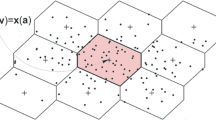Abstract
In this paper we introduce the quadratically constrained integer least-squares problem and show how the LAMBDA method can be used to solve it for the purpose of GNSS attitude determination. The integer least-squares principle with quadratic equality constraints (ILSQE) is used to formulate our cost function. The solution of the ILSQE problem is derived and it is shown how the solution can be computed efficiently and rigorously with a novel LAMBDA based method. Experimental results with various single frequency GPS receivers are given to show the effectiveness of the proposed method. The method is also compared with some current methods of GNSS attitude determination. Apart from its efficiency, the proposed method is shown to dramatically improve the success rates of integer ambiguity GNSS attitude resolution.
Similar content being viewed by others
References
Ashtech, “ADU5: GNSS sensors and marine survey solutions,” http://products.thalesnavigation.com/en/products/index.asp , 2003.
I. Y. Bar-Itzhack, P. Montgomery, and J. Garrick, “Algorithm for attitude determination using GPS,” Proc. of AIAA Guidance, Navigation and Control Conf., New Orleans, LA, USA Paper no. AIAA 97-3616, Aug. 1997.
C. E. Cohen, Attitude Determination Using GPS, Ph.D. Thesis, Stanford University, 1992.
Furuno Electric Co., “Model SC-120: Satellite compass,” http://www.furuno.co.jp/english/index.html, 2003.
G. H. Golub and C. F. van Loan, Matrix Computations, 2nd edition, The Johns Hopkins University Press, Baltimore, Maryland, USA, 1998.
R. R. Hatch and H. J. Euler, “Comparison of several kinematic techniques,” Proc. of ION GPS-94, Salt Lake City, Utah, USA pp. 363–370, September 20–23, 1994.
P. J. Jong de and C. C. J. M. Tiberius, The LAMBDA Method For Integer Ambiguity Estimation: Implementation Aspects, Delft Geodetic Computing Centre LGR series, no. 12, 1996.
P. Joosten, The LAMBDA-Method: Matlab™ Implementation. Matlab Toolbox and Manual, Mathematical Geodesy and Positioning, TU Delft, 2001.
G. Lu, “Development of a GPS multi-antenna system for attitude determination,” UCGE Reports 20073, Dept. of Geomatics Eng., University of Calgary, 1995.
C. Park, I. Kim, G. I. Jee, and J. G. Lee, “Efficient ambiguity search using constraints equation,” Proc. of IEEE Position, Location and Navigation Symposium PLANS’96, Atlanta, Georgia, USA, 1996.
C. Park, I. Kim, G. I. Jee, and J. G. Lee, “Efficient technique to fix GPS carrier phase integer ambiguity on-the-fly,” IEE Proceedings, Radar, Sonar and Navigation, vol. 144, no. 3, pp. 148–155, 1997.
C. Park and I. Kim, “An error analysis of 2-dimensional attitude determination using global positioning system,” IEICE Transaction on Communications, vol. E83-B, no. 6, pp. 1370–1373, 2000.
C. Park and P. J. G. Teunissen, “A baseline constrained LAMBDA method for an integer ambiguity resolution of GNSS attitude determination system,” Journal of Institute of Control, Robotics and Systems (in Korean), vol. 14, no. 6, pp. 587–594, June 2008.
P. J. G. Teunissen, Least-squares Estimation of the Integer Ambiguities, Delft Geodetic Computing Centre LGR series, no. 6, 1993.
P. J. G. Teunissen, “A new method for fast carrier phase ambiguity estimation,” Proc. of IEEE Position, Location and Navigation Symposium PLANS’94, Las Vegas, NV, USA, pp. 562–573, April 11–15, 1994.
P. J. G. Teunissen and A. Kleusberg editors, GPS for Geodesy, 2nd edition, Springer-Verlag, Berlin, Germany, 1998.
P. J. G. Teunissen, “Success probability of integer GPS ambiguity rounding and bootstrapping,” Journal of Geodesy, vol. 72, pp. 606–612, 1998.
P. J. G. Teunissen, “GNSS ambiguity bootstrapping: theory and application,” Proc. of International Symposium on Kinematic Systems in Geodesy, Geomatics and Navigation, Banff, Canada, pp. 246–254, 2001.
P. J. G. Teunissen, “Theory of carrier phase ambiguity resolution,” Proc. of the 9th GNSS workshop-2002 International Symposium on GPS/GNSS, November 6–8, Wuhan, China, 2002.
C. C. J. M. Tiberius, Recursive Data Processing for Kinematic GPS Surveying, Ph.D. Thesis, Mathematical Geodesy and Positioning, TU Delft, 1998.
C. H. Tu, K. Y. Wang, and W. C. Melton, “GPS compass: a novel navigation equipment,” Proc. of ION National Technical Meeting, Santa Monica, CA, USA, 1996.
S. Verhagen, Visualization of GNSS-related design parameters. Manual for Matlab User Interface Visual, Mathematical Geodesy and Positioning, TU Delft, 2002.
M. Ziebart and P. Cross, “LEO GPS attitude determination algorithm for a macro-satellite using boom-arm deployed antennas,” GPS Solutions, vol. 6, pp. 242–256, 2003.
Author information
Authors and Affiliations
Corresponding author
Additional information
Recommended by Editor Hyun Seok Yang. This research was supported by Basic Science Research Program through the National Research Foundation of Korea(NRF) funded by the Ministry of Education, Science and Technology (No. R11-2008-014-02001-0). The research of the second author was done in the framework of his ARC International Linkage Professorial Fellowship, at Curtin University of Technology, Perth, Australia, with Professor Will Featherstone as his host. These supports are greatly acknowledged.
Chansik Park received the B.S., M.S., and Ph.D. degrees in Electrical Engineering from Seoul National University in 1984, 1986, and 1997 respectively. He is currently with the School of Electrical and Computer Engineering, Chungbuk National University, Cheongju, Korea. His research interests include GNSS, SDR, AJ, ITS and WSN.
Peter J. G. Teunissen has 20 years of research experience in GNSS Positioning and Navigation. He is the inventor of the LAMBDA method for GNSS carrier phase ambiguity resolution. He is the Head of the Department of Earth Observation and Space Systems of the Delft University of Technology and a member of the Royal Netherlands Academy of Sciences.
Rights and permissions
About this article
Cite this article
Park, C., Teunissen, P.J.G. Integer least squares with quadratic equality constraints and its application to GNSS attitude determination systems. Int. J. Control Autom. Syst. 7, 566–576 (2009). https://doi.org/10.1007/s12555-009-0408-0
Received:
Revised:
Accepted:
Published:
Issue Date:
DOI: https://doi.org/10.1007/s12555-009-0408-0




